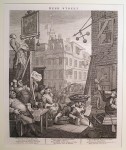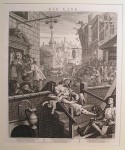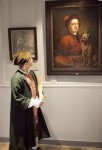 Eighteenth century painter, engraver and social satirist William Hogarth’s house in Chiswick, West London, has reopened after an extensive three-year restoration. It’s been a longer voyage than originally planned.
Eighteenth century painter, engraver and social satirist William Hogarth’s house in Chiswick, West London, has reopened after an extensive three-year restoration. It’s been a longer voyage than originally planned.
 Hogarth, famous for his satirical prints condemning social ills of the era like the cheap gin that drove the poor to unemployment, dissolution, suicide, and the dangers of moral laxity among the moneyed classes, purchase the 1715 house as a country home in 1749.
Hogarth, famous for his satirical prints condemning social ills of the era like the cheap gin that drove the poor to unemployment, dissolution, suicide, and the dangers of moral laxity among the moneyed classes, purchase the 1715 house as a country home in 1749.  Chiswick was a small village surrounded by fields back then. Now it’s a suburb of London, dwarfed by sprawl and the A9 highway.
Chiswick was a small village surrounded by fields back then. Now it’s a suburb of London, dwarfed by sprawl and the A9 highway.
The house was closed to the public for renovation in September 2008. The construction work was finished by July of 2009 with only the museum’s new installations left to do before the scheduled reopening. Then a fire broke out in the electrical closet under the staircase. Firemen put out the blaze promptly but the damage was sufficient to require an additional two years of renovation. Thankfully the large collection of Hogarth’s prints owned by the museum trust was still in storage at the time of the fire.
 The fire ended up being more blessing than curse in some ways. It revealed the original wood flooring of the house, and engendered major grants from the Heritage Lottery Fund, the John & Ruth Howard Charitable Trust, the Old Chiswick Protection Society and the William Hogarth Trust for a more complete renovation, the first full refurbishment of the house in 60 years. Along with the floors, the wall paneling was restored and fireplaces reopened. Also, experts in historical paint colors performed a detailed analysis of the original wall colors and recreated them exactly, so the current interior palette of grays and pinks is authentic to the house when Hogarth lived there.
The fire ended up being more blessing than curse in some ways. It revealed the original wood flooring of the house, and engendered major grants from the Heritage Lottery Fund, the John & Ruth Howard Charitable Trust, the Old Chiswick Protection Society and the William Hogarth Trust for a more complete renovation, the first full refurbishment of the house in 60 years. Along with the floors, the wall paneling was restored and fireplaces reopened. Also, experts in historical paint colors performed a detailed analysis of the original wall colors and recreated them exactly, so the current interior palette of grays and pinks is authentic to the house when Hogarth lived there.
 The contents of the house are also true to the period, many of them artifacts original to the home that had long since been scattered. There are replicas of furniture depicted in Hogarth’s prints, his eye glasses, a Chinese porcelain punchbowl that the Hogarths must have loved because it was broken and mended several times, the stand for his pug’s food bowl, Hogarth’s painting chest, original engraved plates, even his palette — later used by J.M.W. Turner — which was loaned to the museum by the Royal Academy.
The contents of the house are also true to the period, many of them artifacts original to the home that had long since been scattered. There are replicas of furniture depicted in Hogarth’s prints, his eye glasses, a Chinese porcelain punchbowl that the Hogarths must have loved because it was broken and mended several times, the stand for his pug’s food bowl, Hogarth’s painting chest, original engraved plates, even his palette — later used by J.M.W. Turner — which was loaned to the museum by the Royal Academy.
There are also portraits of Hogarth’s sisters (copies of originals now owned by Yale University) and his servants, a mourning ring for William’s wife Jane, and a number of other personal artifacts that belonged to his family members who remained in the house until 1808. The idea is to give a sense of how people lived in the house, not just to present a viewing gallery of Hogarth’s prints, which is why the curators have collected information about the various characters who lived there before and after the Hogarths as well.
 The ground floor and first floor are open to the public. The ground floor includes a really smart feature that should be included in every museum of a historical house: computer displays that allow people who can’t climb the stairs to the second floor to take a virtual tour of the upstairs living quarters.
The ground floor and first floor are open to the public. The ground floor includes a really smart feature that should be included in every museum of a historical house: computer displays that allow people who can’t climb the stairs to the second floor to take a virtual tour of the upstairs living quarters.
Another brilliant idea implemented by the museum is to offer replica 18th century suits for children to wear and compare themselves to the period portraits while they visit the house. I can’t even tell you how ecstatic I would have been to get to roam a museum in full costume.
The Hogarth’s House museum opened to the public on Tuesday, November 9th, the day before Hogarth’s 314th birthday. It’s open from noon to 5 PM, Tuesday through Sunday and admission is free. You can take a virtual tour of your own and learn more about Hogarth’s work with this audio slideshow from the BBC, narrated by Antiques Roadshow expert Lars Tharp.